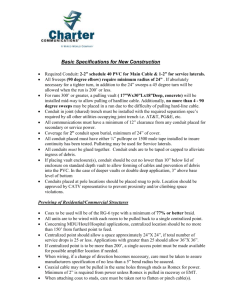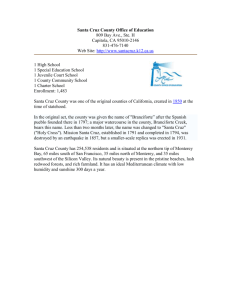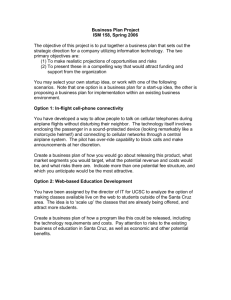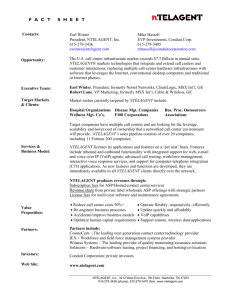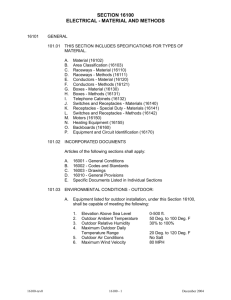doc - Tellus Venture Associates
advertisement
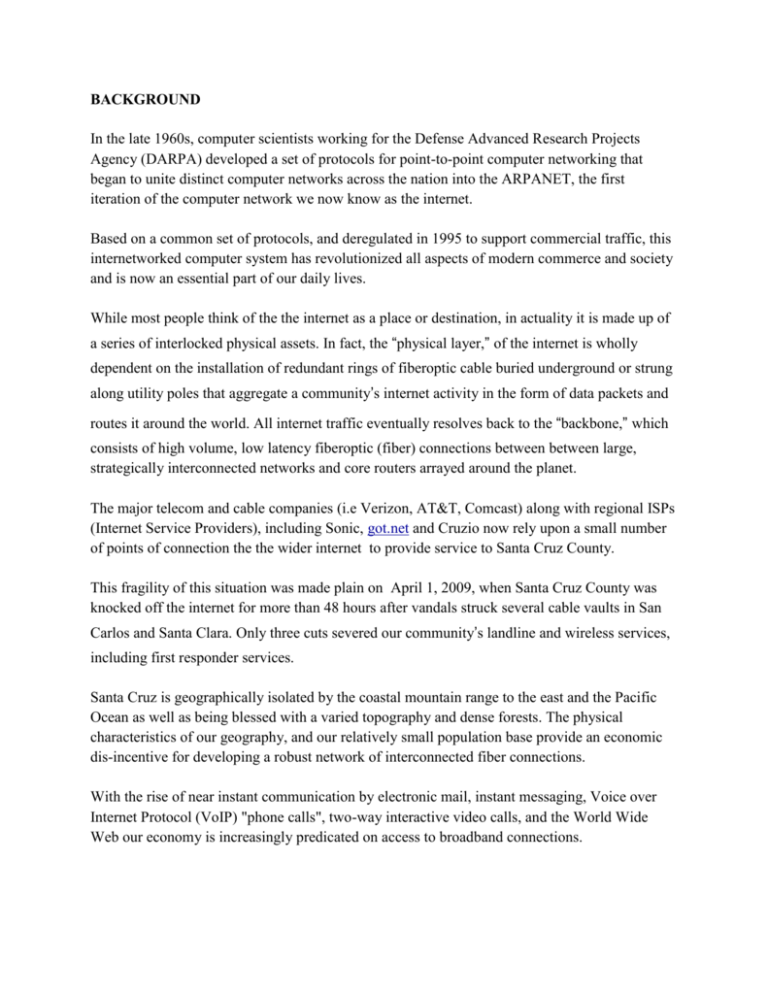
BACKGROUND In the late 1960s, computer scientists working for the Defense Advanced Research Projects Agency (DARPA) developed a set of protocols for point-to-point computer networking that began to unite distinct computer networks across the nation into the ARPANET, the first iteration of the computer network we now know as the internet. Based on a common set of protocols, and deregulated in 1995 to support commercial traffic, this internetworked computer system has revolutionized all aspects of modern commerce and society and is now an essential part of our daily lives. While most people think of the the internet as a place or destination, in actuality it is made up of a series of interlocked physical assets. In fact, the “physical layer,” of the internet is wholly dependent on the installation of redundant rings of fiberoptic cable buried underground or strung along utility poles that aggregate a community’s internet activity in the form of data packets and routes it around the world. All internet traffic eventually resolves back to the “backbone,” which consists of high volume, low latency fiberoptic (fiber) connections between between large, strategically interconnected networks and core routers arrayed around the planet. The major telecom and cable companies (i.e Verizon, AT&T, Comcast) along with regional ISPs (Internet Service Providers), including Sonic, got.net and Cruzio now rely upon a small number of points of connection the the wider internet to provide service to Santa Cruz County. This fragility of this situation was made plain on April 1, 2009, when Santa Cruz County was knocked off the internet for more than 48 hours after vandals struck several cable vaults in San Carlos and Santa Clara. Only three cuts severed our community’s landline and wireless services, including first responder services. Santa Cruz is geographically isolated by the coastal mountain range to the east and the Pacific Ocean as well as being blessed with a varied topography and dense forests. The physical characteristics of our geography, and our relatively small population base provide an economic dis-incentive for developing a robust network of interconnected fiber connections. With the rise of near instant communication by electronic mail, instant messaging, Voice over Internet Protocol (VoIP) "phone calls", two-way interactive video calls, and the World Wide Web our economy is increasingly predicated on access to broadband connections. Given this reality. our community will be at an economic disadvantage is we are not able to incentivize or facilitate the further development of more physical resources for internet traffic, particularly to our community anchor organizations (schools, public safety, health care) and employers (technology, research and development, climate science and genomics). Maintaining a robust broadband infrastructure is not just a matter of creating jobs and stimulating economic growth. Ultimately, it is a matter of economic necessity and survival in the globallyconnected marketplace. The most helpful role a municipality can take to foster investment in broadband is to reduce the barriers to deployment and increase investment and competition for broadband infrastructure development without interfering in consumer choice. DISCUSSION Santa Cruz is not alone in facing an economic equation that hampers the development of a more robust fiber network. A number of cities have instituted policies that are specifically set up to lower the barriers to entry for internet infrastructure development either through laying “dark fiber,” which is unlit (inert) fiberoptic cable in city-owned conduits (City of Sacramento, Washington DC) or developing policies that support the creation and rental of city-owned conduits under streets and between anchor organizations. Milpitas, Fresno and Modesto) Due to the challenges facing California communities and the relative high cost of fiberoptic cable, it is staff’s recommendation to pursue development of conduit runs rather than the purchase and installation of “dark fiber” resources. This approach to infrastructure development will allow the City to create a capital asset that can be rented to telecommunications companies on a per linear foot per year revenue model while lowering the capital costs for businesses and ISPs / telecom companies to deploy fiber resources in the community. By putting the broadband conduit in place while the ground beneath the roadway or sidewalk is exposed during a capital improvement project, the City can enable any authorized communications provider to install fiber-optic cable at far less cost at a later date and avoid tearing up our roads and highways needlessly preserving existing resources while planning for future advancements in internet infrastructure. This issue has been at the forefront of Federal efforts to stimulate broadband adoption and deployment. Several large municipalities have taken the lead in developing policies that Santa Cruz can emulate and adapt. In Boston, after a company takes the lead role in requesting an open trench, the city’s “Shadow Conduit Policy,” allows others companies to add additional empty (or “shadow”) conduit for future use by either the city of Boston or a later entrant. This ordinance was adopted by the Public Improvement Commission and entitled “Policy Relating to Grants of Location for New Conduit Network for the Provision of Commercial Telecommunications Services,” adopted on August, 4, 1988. In San Francisco, the Board of Supervisors has implemented a notification process, which ensures that other interested parties have an opportunity to install conduits and cabling when work is already being done in an open trench. This ordinance was advanced by the Dept. of Public Works as Order No. 176,707 and was most recently revised in March 26, 2007. The Federal Communication Commission’s Internet Policy Statement (FCC 05–151, adopted August 5, 2005) sets four guidelines for municipalities and public agencies to consider when developing physical infrastructure for data networks: a.) Preserve and promote the open and interconnected nature of the public Internet; b.) Protect consumer choice to that citizens may run applications and use services of their choice; c.) Protect consumer choice with respect to the interconnection of legal devices that do not harm the network; and d.) Foster competition among network providers, application, service and content providers. RECOMMENDATION The City Council’s Ad-Hoc Technology Committee is recommending a multi-phased approach to developing fiber conduits within City limits. The Committee is also recommending that the City Council direct City engineers, planners and project mangers incorporate conduit planning into the Capital Improvement Project chartering process in an attempt to lay the foundation for more robust internet infrastructure in future years. For some areas where construction is taking place it might not be feasible or necessary to install a broadband conduit. In order to guide this process, the Committee is recommending that Council direct the Information Technology Division of the Administrative Services Department to develop maps showing the highest priority routes for conduits in future years, with an emphasis on lowering the cost for telecom, cable and ISP concerns to deliver high bandwidth services to Santa Cruz’s industrial and community commercial land use districts; particularly along major arterial roads, downtown, Harvey West and the far Westside Industrial lands. The placement of conduit should be evaluated for CIP projects by the Information Technology department, with a cost analysis performed indicating the cost savings introduced by placing conduit in conjunction with the project. This analysis will be reviewed by the project manager from Public Works or Water as well as the CTO and the City Manager’s Office. This would bring Santa Cruz CIP planning into alignment with other forward thinking communities in the state and allow for the continued development of high bandwidth industries in Santa Cruz County. FISCAL IMPACT The Federal Highway Administration estimates that It is ten times more expensive to dig up and then repair an existing road to lay fiber than to dig a channel for it when the road is being fixed or built. According to estimates provided the the House of Representatives by the Telecommunications Industry Association (TIA), “more than half of the costs of new broadband deployment are expenses that can be ascribed to the digging up and repaving of roadways. Further, it is estimated that the inclusion of broadband conduit in [roadway] construction would add less than 1% to the cost of the overall project.” Conduit leases can provide a significan source of revenue for municipalities. The City of Baltimore leases conduit at $1.16 per linear foot per year to a variety of telecom companies, while the City of Milpitas, California derives $6,014.82 a year for the conduit it leases to XO Communications. Over the 30 year lease executed with XO, Milpitas will add $180,444.64 to their fund balances for a downtown fiber loop consisting of 20,917 linear feet. In 2010, Tumwater, Washington leased 3,758 linear feet of conduits to CenturyLink for $2.05 a year per linear foot. The contract structured to capture $2.25 per linear foot per year in 2016. Provo Utah leases 1,008,066 linear feet of aerial attachments, 542,825 underground conduit and 232,639 dedicated conduit to Broadweave Networks for 60 cents a linear foot underground and $12.33 per pole per year. ENVIRONMENTAL IMPACT As any potential project would have to go through the City’s existing CIP process, CEQA and/or NEPA clearances will be collected by staff before deployment. SUBMITTED BY
